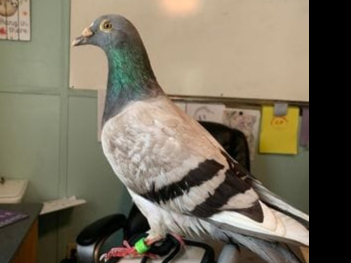We receive dozens of calls a year from people who are concerned- that a large pigeon with a ring, or rings, on its leg has been hanging around their garden for a day or so.
These calls usually come in the summer months when pigeon races are more regularly held, and some birds are either blown off course or need to stop for a rest.
Just how Bob, the Tyneside pigeon, ended up in Alabama in the USA last month will probably always remain a mystery.
Homing pigeons can fly hundreds of miles without stopping, and up to 800 miles a day, at more than 60 miles per hour; but Bob was covered in oil when he was found and so he may have hitched a lift on a trans-Atlantic ship.
Bob was released from Guernsey in a race that should have seen him return to his loft in Gateshead within a couple of days, and his owner had given up hope that he would ever see Bob again.
A significant number of racing pigeons die from dehydration and exhaustion, and some are killed by predators such as birds of prey and cats.
And so Bob’s owner was more than a little surprised to receive a call from an animal shelter in Alabama saying that Bob had been brought to them by an elderly gentleman who had found him in his back garden.
It is thought that Bob was caught up in a storm, or a change in atmospheric conditions, which will have compromised his ability to use the earth’s magnetic field to navigate.
At four years old Bob is a seasoned racer and he has won two big races from France, which explains why his owner wanted him back and was prepared to travel to the USA to collect him.
His racing days are over, though, and apparently he will live out the rest of his life as a breeding bird.
Bob is probably worth about £1,000 as a successful racer, but he’s positively cheap in comparison to the world’s most expensive birds.
Fanciers in the Arab Emirates and China have pushed up prices, and a Belgian female bird sold last year for a staggering £1.5 million.
So what should you do if you find a racing pigeon in your garden?
Simply give the bird some fresh water in a deep dish, along with some bird seed, crushed cornflakes, or uncooked rice or lentils (but not bread), and before too long it will resume its journey home.
But if the bird doesn’t leave after several days, or it appears injured, you may be able to find the owner’s contact details on a ring on the bird’s leg.
At the very least there will be a registration number that you can then report to the Royal Pigeon Racing Association via their website www.rpra.org/stray-reporting.
The best way to pick up a racing pigeon is to gently throw a towel over it, and then to place it in a ventilated box.
These birds are used to being handled and so should not be too stressed by human interaction.
If the bird is visibly injured you should take it straight to a vet who will give it emergency treatment free of charge, but please remember to phone ahead (you will be asked to take extra biosecurity measures because of the heightened risk of avian influenza).
When contacted, most bird owners will ask that their pigeons be left to find their own way home, although we have put the odd one or two birds on a boat back to the UK.
A bird that doesn’t have a good racing record is not particularly valued by its owner who will view it as inferior stock.
However, the RSPB reports that some racing pigeons can ‘go native’ and survive quite happily out in the wild.
Let’s hope Bob has several years as a celebrity ahead of him, as the most talked about bird in the country.

.png?width=209&height=140&crop=209:145,smart&quality=75)
.jpeg?width=209&height=140&crop=209:145,smart&quality=75)


Comments
This article has no comments yet. Be the first to leave a comment.